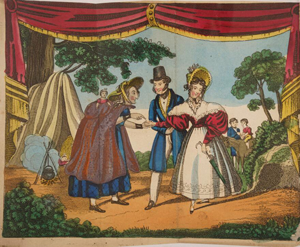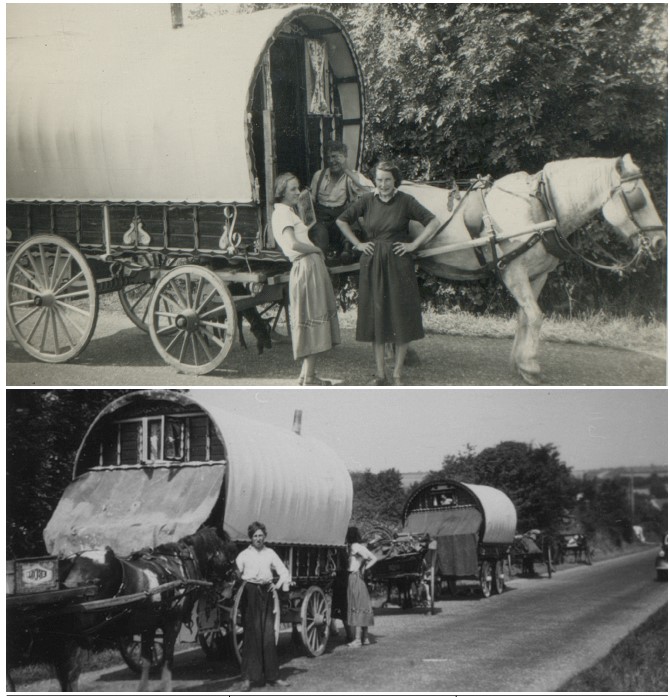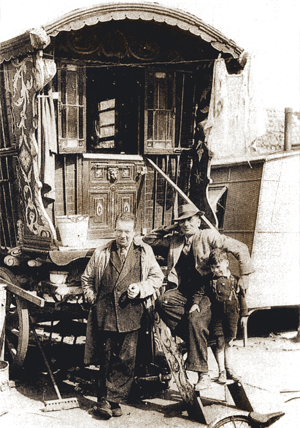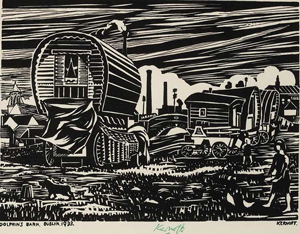GYPSIES IN IRELAND—A HIBERNO-ROMANY COMMUNITY
Published in Features, Issue 3 (May/June 2023), Volume 31By David Joyce

Above: A mid-nineteenth-century colour plate of ‘Epping Forest Gypsies’, a noted group of Romani who travelled around Britain and began ‘opening’ their campsites to visitors sometime in the early 1860s.
‘Travelling community’ is used as an all-encompassing term in Ireland to describe a traditionally nomadic community that has a significant degree of internal diversity. Encompassed within the term are distinct groups, namely Mincéirí or Pavee and Romani travellers. Mincéirí or Pavee are used interchangeably as a self-descriptive term by Irish Travellers; Romany/Romani is a self-descriptive term used by English Gypsies. What are the origins in Ireland of the small but distinct Hiberno-Romany community?
Romani history in Britain has been widely studied and there is a growing body of study in relation to Mincéirí in Ireland and Britain, but the study of Romani in Ireland has been neglected. When writing about the ‘Travelling community’ in Ireland, many writers repetitively cite limited sources that suggest that Romani never lived or travelled in Ireland until appearing briefly at the outbreak of the First World War, suggesting that they migrated to Ireland to avoid military conscription in Britain. While some families did move to Ireland during the Great War, Romani families had already developed travel circuits within Ireland from the late 1860s. By the early 1940s many of these families had been connected to Ireland for at least two or three generations and began to form a distinct Hiberno-Romany community.
THE ORIGINS OF THE ROMANY COMMUNITY IN IRELAND
The first explicit reference to the presence of Romani in Ireland dates from the early sixteenth century. The Fiants of Henry VIII in 1541 record ‘Safe conduct, for 40 days, for John Naune and his company, Egyptians, driven from Scotland by stress of weather’. ‘Egyptian’ was a term for Romani in the sixteenth century, based on the unfounded belief that the wanderers then arriving in Western Europe were ‘pilgrims’ originating from Egypt. The word ‘Gypsy’ derives from the various spellings used—Egipcian, Egypcian, ’gypcian. This record of Romani in Ireland in 1541 is contemporaneous with the first records of Romani in Scotland and England in the early sixteenth century and coincides with the introduction of punitive laws designed to deter Gypsies from entering or remaining in Scotland ‘on pain of death’.

Above: The Gentles—seen here on the road near Kinsale, Co. Cork, in the 1950s—were Welsh Romani who had travelled in Ireland since the 1890s. (University of Liverpool)
It is suggested that the appearance of Romani in Ireland in the 1540s was almost certainly an aberration and they did not establish a permanent presence. There is little reference or evidence of Romani in Ireland in the succeeding centuries. It is not until the nineteenth century that verifiable records of Romani in Ireland appear.
THE ROMANY COMMUNITY IN IRELAND IN THE NINETEENTH CENTURY
One such record of a transitory family of Romani is from 1866, when a group of families temporarily disembarked from a steamship in Queenstown (Cobh). The ship was bound for the United States but docked in Queenstown for repairs. The families were said to be emigrating because the enclosure of commonage in England made nomadism increasingly difficult. They families stated that ‘the prejudice which is gradually rising against them’ was another reason they were leaving England. Unfortunately, the prejudice experienced in England was repeated in Cork. When they sought to set up a campsite on the outskirts of Cobh, a large crowd of locals prevented them from doing so. It was reported that locals had gathered ‘en masse’ and hunted them for a couple of miles around the countryside, not allowing them to pitch their tents anywhere. The families were forced back into Queenstown, where they slept on the streets until the ship departed.
The first appearance of Romani living in a ‘gypsy caravan or vardo’ dates from 1868 in Belfast. A group of families calling themselves ‘the Original Norwood and Epping Forest Gipsies’ are described as ‘causing a great attraction in the city’. The camp was recorded as having three ‘caravans’ and a number of tents. The same group later moved to Dublin, where their camp at the Rotunda Gardens was open to the public, who were charged sixpence for admission.
The ‘gipsy caravan’, or vardo in the Romani language, as a form of accommodation dates from the early 1840s. The first living vans were large transport wagons that combined storage and living space into one vehicle pulled by a team of horses and used as living accommodation in France in the 1810s by non-Romani circus troupes. By the mid-1800s they had become smaller, pulled by a single horse. In the mid-1840s Romani in Britain started using vardos, adding their own characteristic style of decoration.
The Epping Forest Gypsies were a noted group of Romani who travelled around Britain and began ‘opening’ their campsites to visitors sometime in the early 1860s. Many of them were musicians and put on shows and dances as well as engaging in fortune-telling and selling their handmade wickerwork products from their campsites. George ‘Lazzy’ Smith, an entrepreneurial Romany, claimed to have originated the idea of charging members of the public to see inside their tents and attend the dances. When he noticed the interest in the arrival of Romani in towns around England, to ‘the extent that onlookers would not keep out of their tents even at meal-times’, he decided to profit from this curiosity.
The arrival of the group in Belfast was clearly a ‘commercial operation’ with an element of carnival attached. The Epping families returned to Ireland in March 1870, visiting Cork and Limerick. In a lengthy report in the Freeman’s Journal on the arrival of the group in Dublin in September 1868 entitled ‘The Gipsies in Ireland’, it was stated ‘that we now have a veritable gipsy encampment in Ireland, the first, according to certain statements, that ever visited this kingdom’. The writer questioned the veracity of the claim and drew a comparison between the way of life of Romani and ‘tinkers’, and the article colourfully ponders whether ‘gipsies’ were present in Ireland from an earlier era. The writer stated that an ‘examination of the habits and manners of the tinkers’ then travelling around Ireland as tinsmiths and horse-dealers suggested ‘that the race had, in common with more objectionable ones, made a settlement in our midst. They took kindly to the soil, and learned the use of the blackthorn, adopting also the native patois—Indeed they became what the English call “more Irish than the Irish”.’ The direct comparison between ‘tinkers’ and Romani suggests that Irish Travellers had been living in distinct campsites using tents for many years prior to the arrival of the ‘Gipsies’.
THE ESTABLISHMENT OF A HIBERNO-ROMANY COMMUNITY, 1870s–1900
Apart from his connections to the Epping Forest group, Lazzy Smith frequently travelled around Ireland as a horse-dealer, and several of his children were born in Ireland. Other Romani families also came to Ireland to pursue economic opportunities. By the late 1860s Romani hawkers and horse-dealers in single families or small family groups with horse-drawn caravans and tents became a presence on the roads of Ireland. Families recorded around that time included Smiths, Lees, Palmers and Reynoldses.
One significant record of Romani hawkers in Ireland comes from a court case in 1874. This case is an early example of Travellers, either Romani or Mincéirí, resorting to the superior courts to assert a legal right. It is also an example of holding Travellers collectively responsible for the actions of an individual from within the community.
The case was taken by William Smith and his mother Eliza against Robert Talbot, a draper from Westport, Co. Mayo. The Smiths were described in court records as ‘English gipsies’. Talbot had the previous November obtained a court order allowing the county sheriff to seize the property of the Smiths in satisfaction of a debt run up by the Smiths’ in-law John Lee. The property consisted of the family’s caravan, tent, cart, harness, horse, clothes and other personal property. The Smiths had been camped at Temple Road, Blackrock, Co. Dublin, when their property was seized. The court heard that William Smith and his mother, together with other family members, had previously been camping in Westport, where John Lee had become indebted to Talbot for £40 for blankets that he had bought to sell on as a hawker. Lee had married William Smith’s sister sometime previously and had been unsuccessful as a horse-dealer. The Lees returned to the Smiths’ camp and were allowed to reside there but had no property in it. The Smiths argued that ‘the transaction between Lee and Talbot was entirely unconnected with them and imposed no liability on the Smiths’. The jury held in favour of the Smiths and the court ordered the return of their property.
In July 1876 possibly the same John Lee was involved in an incident in Portadown, Co. Armagh. Lee, the head of a ‘Gipsy encampment’, was the victim of an assault when five men entered his camp and severely beat him. It appeared that a horse belonging to Lee had somehow torn the coat of one of the men earlier in the day at a nearby water pump; during this incident he exchanged words with Lee, before returning later with four other men. The group were convicted and fined.
By the 1890s Romani travelling in vardos were a common sight. One of the first fatal accidents involving a vardo is recorded in County Cork in 1897, where the death of teenager Charlotte Jones occurred. Charlotte was the niece of William Gentle, a Welsh Romany who had been travelling with his family in Ireland from around 1890. On the evening of 12 March 1897 they were encamped near Kinsale when strong winds overturned one of the caravans and crushed the unfortunate Charlotte to death. The extended Gentle family were recorded later in 1897 in occupation of three caravans at Rathkeale, Co. Limerick.
THE ROMANY COMMUNITY IN IRELAND, 1900–1960s

Above: Members of the Taylor family in front of their vardo in Gardiner Street in 1952. (Historical Picture Archive)
The Gentles, Smiths, Lees, Wilsons, Webbs, Reis, Boswells and Brasils, among other families, had established routes and stopping places around Ireland by the beginning of the twentieth century. Most of these families are recorded in the 1901 and 1911 censuses. Members of the Webb, Wilson and Smith families were among the few travelling families recorded in occupation of a ‘Gipsy wagon’ or vardo in the 1911 census.
It is widely accepted that Mincéirí did not use horse-drawn wagons as living accommodation until the mid-1910s. Just as the Romani had adapted the wagon from circus folk, it is suggested that Mincéirí adapted the wagon from Romani who had begun travelling with them in Ireland during the Great War. Given, however, that Romani vardos had a presence in Ireland for much of the previous 40 years, it is likely that some Mincéirí, particularly wealthier families, may have been using them from an earlier period.
Irish Travellers almost exclusively opted for the canvas-covered bow-top wagon rather than the square-sided Reading- or Burton-type vardo, a style of van more evocative of the Romani community. The bow-top had a number of advantages over other types of van in terms of cost and weight; in addition, because of its simpler design it was easier to construct than the more elaborate and ornate vardos.
Many of the campsites of Romani, particularly during the wintertime, were in urban areas. Parts of Dublin from Dolphin’s Barn inwards toward the Liberties and stretching across the river to Gardiner Street, Dorset Street and Ballybough were well-known stopping places. One of the better known of these campsites was at Dolphin’s Barn Bridge, where the death of two little Romany girls, Eileen and Kathleen Riley, was recorded in March 1915, when the bender tent they were living in caught fire. The stopping place at Dolphin’s Barn was later depicted by the artist Harry Kernoff in his evocative woodcut ‘Dolphin’s Barn, Dublin, 1933’.
The presence of a significant number of Romany families in Dublin during the 1930s and 1940s was recorded by the Irish Press and Irish Times respectively. In 1936 the Irish Press reported on a number of families in Gardiner Street, where nine caravans were on a campsite. In 1945 the Irish Times met and identified a number of families and campsites, including Taylors, Bolands, Scotts and Dalys on Gardiner Street, O’Neills on Dorset Street, Webbs at Thomas Street, and the Riley and Sturgeon families in Harold’s Cross. It was noted that the Taylor family had been living on the site in Gardiner Street for more than fourteen years.
The stopping places of the Romany families in the environs of Dublin city and other parts of the country are now forgotten, and many of the families who lived and travelled in Ireland from about the 1870s until the 1950s appear to have migrated to Britain during the 1950s and ’60s, a migration in which many Mincéirí also took part. Some, however, married into non-Romany families in the parts of Dublin and other parts of the country in which they lived and became assimilated into those neighbourhoods. A number of families remain in Ireland, north and south, and proudly identify as Irish Romany.
David Joyce is a solicitor and a member of the Irish Traveller community.
Further reading
A. Bhreatnach, Becoming conspicuous: Irish Travellers, society and the state 1922–70 (Dublin, 2007).
J. Helleiner, Irish Travellers: racism and the politics of culture (Toronto, 2000).
M. McCann, S. Ó Síocháin & J. Ruane (eds), Irish Travellers, culture and ethnicity (Belfast, 1994).
S. ní Shuinéar, ‘Apocrypha to canon: inventing Irish Traveller history’, History Ireland 12 (4) (2004).
G. Power, ‘Gypsies and sixteenth-century Ireland’, Romani Studies 24 (2) (2014).


















